您好,登錄后才能下訂單哦!
您好,登錄后才能下訂單哦!
本篇內容主要講解“如何理解SpringBoot接口接收json參數”,感興趣的朋友不妨來看看。本文介紹的方法操作簡單快捷,實用性強。下面就讓小編來帶大家學習“如何理解SpringBoot接口接收json參數”吧!
通常來講,HTTP 方法會映射為 CRUD 動作,但這并不是嚴格的限制,有時候 PUT 也可以用來創建新的資源,POST 也可以用來更新資源。所以在平時的 Web 開發中,你可能常看到method 的值是 GET 和 POST,但是我們需要養成一個好的編碼習慣。
| CRUD 動作 | HTTP 方法 |
|---|---|
| Create | POST |
| Read | GET |
| Update | PUT(全部資源) 或 PATCH(部分資源) |
| Delete | DELETE |
首先在controller上加上注解:@RestController
@RestController
@RequestMapping("/user")
@Api(tags = "user", description = "用戶控制器")
public class UserController {
// ...
}詳細介紹
1)@PathVariable 獲取路徑參數。即 url/{id} 這種形式。
@GetMapping("/getDetail/{id}")
@ApiOperation(value = "根據id獲取用戶")
public RbacUser getDetail(@PathVariable Long id) {
return userService.getById(id);
}2)@RequestParam 獲取查詢參數。即 url?name=xx 這種形式
主要有參數:
value:參數名字,即入參的請求參數名字,如username表示請求的參數區中的名字為username的參數的值將傳入;
required:是否必須,默認是true,表示請求中一定要有相應的參數,否則會報錯;
@GetMapping("/getByAccount")
@ApiOperation(value = "根據賬號獲取用戶")
public RbacUser getByAccount(@RequestParam(required = false) String account) {
return userService.getByAccount(account);
}3) 直接封裝DTO參數形式
@GetMapping("/find")
@ApiOperation(value = "根據條件獲取用戶")
public List<RbacUser> find(RbacUserDTO rbacUserDTO) {
return userService.find(rbacUserDTO);
}@PathVariable 獲取路徑參數。即 url/{id} 這種形式。
@DeleteMapping("/delete/{id}")
@ApiOperation(value = "刪除用戶")
public void delete(@PathVariable Long id) {
userService.delete(id);
}@RequestBody 將HTTP請求正文插入方法中,使用適合的 HttpMessageConverter 將請求體寫入某個對象。
@PostMapping("/create")
@ApiOperation(value = "創建用戶")
public RbacUser getByAccount(@RequestBody @Validated RbacUserDTO rbacUserDTO) {
return userService.save(rbacUserDTO);
}@Validated:對數據進行校驗,以下注解報錯會直接返回,如果校驗類中包含一個對象引用屬性,需要在屬性上加上@Valid注解
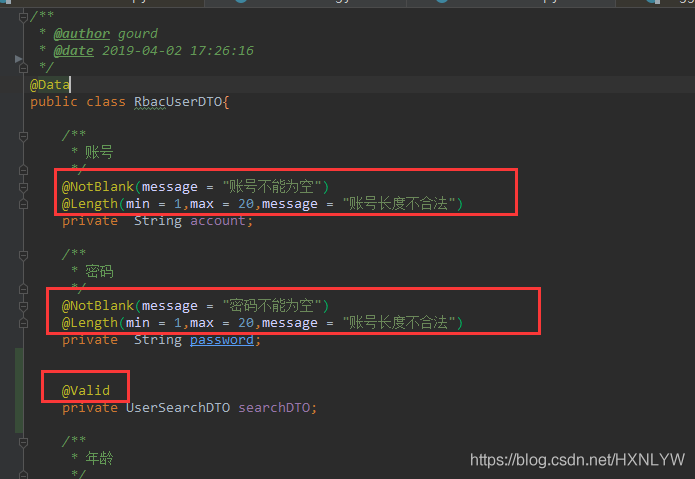
具體參數檢驗請參看下面
對請求參數進行檢驗,這在web中開始經常能碰到,如果用一個個if/else去做判斷,相信這樣的代碼可讀性會比較差
JSR-303 是java為bean數據合法性校驗提供的標準框架,是Java EE6中的一項子規范,叫做BeanValidation。JSR303通過在Bean屬性上標注@NotNull、@Max等標準的注解指定校驗規則,并通過這些標準的驗證接口對Bean進行驗證。
規定一些檢驗規范即校驗注解,如@Null, @NotNull, @Pattern,位于javax.validation.constraints包下,只提供規范 不提供實現。
在Spring中,有兩種方式可以驗證輸入,一是利用Spring自帶的驗證框架,二是利用JSR-303的實現,一般建議使用JSR-303的實現,比如Hibernate-Validator。
Hibernate-Validator 是JSR-303的實現。Hibernate Validator提供了JSR-303規范中所有內置constraint的實現,除此之外還有一些附加的constraint,如@Email, @Length, @Range等,位于org.hibernate,validator.constraints包下。
spring-boot-starter-web包里面已經有了hibernate-vlidator包,不需要額外引用hibernate validator依賴。
同時Spring為了給開發者提供便捷,對Hibernate-Validator進行了二次封裝,封裝了LocalValidatorFactorBean作為validator的實現,這個類兼容了Spring的Validation體系和Hibernate的Validation體系,LocalValidatorFactorBean已經成為了Validator的默認實現。
說明:JSR-349是JSR-303的升級版,添加了一些新特性
如下圖,是spring boot 2.1.1中hibernate依賴情況:

| 屬性 | 描述 | 舉例 |
| @AssertTrue | 應用于boolean屬性,該屬性值必須為true | @AssertTrue boolean isOkay; |
| @AssertFalse | 應用于boolean屬性,該屬性值必須為false | @AssertFalse boolean isOkay; |
| @DecimalMax | 只能小于或等于指定值 | @DecimalMax("1.1") BigDecimal price; |
| @DecimalMin | 只能大于或等于指定值 | @DecimalMin("1.1") BigDecimal price; |
| @Digits | 該屬性值必須在指定范圍內,interger屬性定義該數值的最大整數部分,fraction屬性定義該數值的最大 小數部分 | @Digits(integer=5, fraction=2) BigDecimal price; |
| @Future | 檢查該字段是否是屬于未來的日期 | @Future Date shippingDate; |
| @Max | 該字段的值只能小于或等于該值 | @Max(20) int age; |
| @Min | 該字段的值只能大于或等于該值 | @Min(20) int age; |
| @NotNull | 該字段不能為Null | @NotNull String name; |
| @Null | 該字段必須是Null | @Null String dest; |
| @Past | 該字段必須是過去的一個日期 | @Past Date birthDate; |
| @Size | 檢查該字段的size是否在min和max之間,可以是字符串、數組、集合、Map等 | @Size(min=2, max=10) String description; |
| @Pattern | 該屬性值必須與指定的常規表達式相匹配 | @Pattern(regexp="\\d{3}") String areaCode; |
| @NotBlank | 只用于String, 不能為Null且trim()之后size>0 | @NotBlank String src; |
| @NotEmpty | 不能為Null,且size>0 | @NotEmpty String src; |
| 被注釋的元素必須是電子郵箱地址 | ||
| @Length | 被注釋的字符串String 大小必須在指定范圍內 | @Length(min=6, max=12, message="密碼長度必須在6~12") String src; |
| @Range | BigDecimal,BigInteger,CharSequence, byte, short, int, long等原子類型和包裝類型,驗證注解的元素值在最小值和最大值之間 | |
| @Valid | 指定遞歸驗證(下篇講)關聯的對象; 如用戶對象中有個地址對象屬性,如果想在驗證用戶對象時一起驗證地址對象的話,在地址對象上加@Valid注解即可級聯驗證 |
需要檢驗的Bean定義:
public class StudentBean implements Serializable{
@NotBlank(message = "用戶名不能為空")
private String name;
@Min(value = 18, message = "年齡不能小于18歲")
private Integer age;
@Pattern(regexp = "^((13[0-9])|(14[5,7,9])|(15([0-3]|[5-9]))|(166)|(17[0,1,3,5,6,7,8])|(18[0-9])|(19[8|9]))\\d{8}$", message = "手機號格式錯誤")
private String phoneNum;
@Email(message = "郵箱格式錯誤")
private String email;
public String getName() {
return name;
}
public void setName(String name) {
this.name = name;
}
public Integer getAge() {
return age;
}
public void setAge(Integer age) {
this.age = age;
}
public String getPhoneNum() {
return phoneNum;
}
public void setPhoneNum(String phoneNum) {
this.phoneNum = phoneNum;
}
public String getEmail() {
return email;
}
public void setEmail(String email) {
this.email = email;
}
}返回錯誤字段定義:
public class ArgumentsInvalidResponseBean {
private String argumentName;
private String exceptionMsg;
public ArgumentsInvalidResponseBean() {
}
public ArgumentsInvalidResponseBean(String argumentName, String exceptionMsg) {
this.argumentName = argumentName;
this.exceptionMsg = exceptionMsg;
}
public String getArgumentName() {
return argumentName;
}
public void setArgumentName(String argumentName) {
this.argumentName = argumentName;
}
public String getExceptionMsg() {
return exceptionMsg;
}
public void setExceptionMsg(String exceptionMsg) {
this.exceptionMsg = exceptionMsg;
}
}全局異常處理:
@ExceptionHandler(MethodArgumentNotValidException.class)
@ResponseBody
public List<ArgumentsInvalidResponseBean> methodArgumentNotValidExceptionHandler(MethodArgumentNotValidException ex){
System.out.println("===================methodArgumentNotValidExceptionHandler Occur============");
List<ArgumentsInvalidResponseBean> argumentsInvalidResponseBeanList = new ArrayList<>();
for (FieldError error : ex.getBindingResult().getFieldErrors()){
ArgumentsInvalidResponseBean bean = new ArgumentsInvalidResponseBean();
bean.setArgumentName(error.getField());
bean.setExceptionMsg(error.getDefaultMessage());
argumentsInvalidResponseBeanList.add(bean);
}
return argumentsInvalidResponseBeanList;
}測試代碼:
@RestController
public class CheckController {
@PostMapping("stu")
public String addStu(@Valid @RequestBody StudentBean studentBean){
return "add student success";
}
}在PostMan中測試:
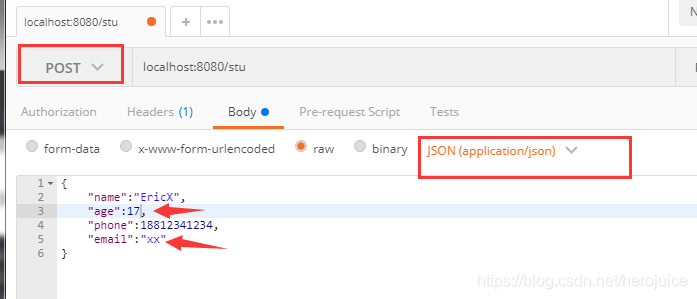
注意這里,年齡和郵箱是有錯誤的,運行后查看返回值,具體如下:
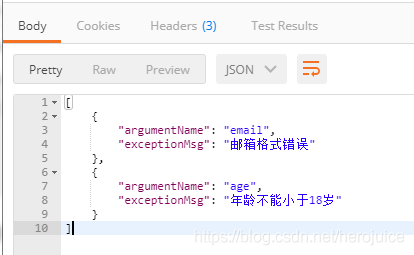
新建注解類 MyConstraint:
@Target({ElementType.METHOD, ElementType.FIELD})
@Retention(RetentionPolicy.RUNTIME)
@Constraint(validatedBy = MyConstraintValidator.class)
public @interface MyConstraint {
String message() default "這是一個自定義注解,檢測輸入是否大寫";
Class<?>[] groups() default {};
Class<? extends Payload>[] payload() default {};
}實現MyConstraintValidator:
public class MyConstraintValidator implements ConstraintValidator<MyConstraint, String> {
@Override
public void initialize(MyConstraint constraintAnnotation) {
System.out.println("+++++++++++++myConstraint init");
}
@Override
public boolean isValid(String o, ConstraintValidatorContext constraintValidatorContext) {
if (!o.equals(o.toUpperCase())){
System.out.println("輸入信息必須是大寫");
return false;
}
return true;
}
}當輸入信息不是全大寫字符時,則檢驗不通過
使用:
在上面StudentBean中加入檢驗
@MyConstraint private String className;
測試:
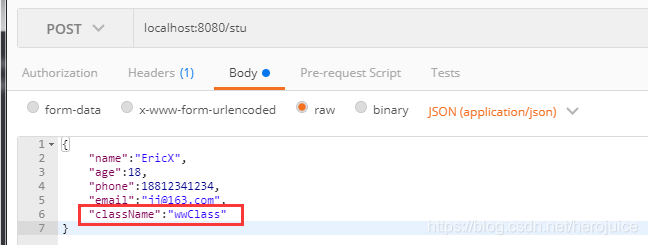
結果如下:
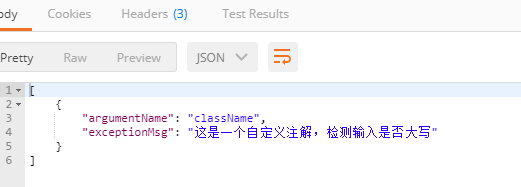
這時說明自定義檢驗可以工作了
當請求中 Content-Type為“application/x-www-form-urlencoded”時,Spring會把數據解析成 web form data而非json,會使用 FormHttpMessageConverter來轉換post的body 并且異常轉為BindException。
如果我們想要Spring把POST數據認為是json并且使用MappingJackson2HttpMessageConverter來解析數據,可以把Content-Type設置成 application/json
到此,相信大家對“如何理解SpringBoot接口接收json參數”有了更深的了解,不妨來實際操作一番吧!這里是億速云網站,更多相關內容可以進入相關頻道進行查詢,關注我們,繼續學習!
免責聲明:本站發布的內容(圖片、視頻和文字)以原創、轉載和分享為主,文章觀點不代表本網站立場,如果涉及侵權請聯系站長郵箱:is@yisu.com進行舉報,并提供相關證據,一經查實,將立刻刪除涉嫌侵權內容。